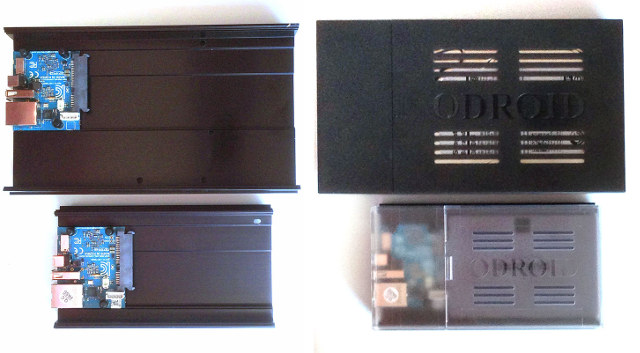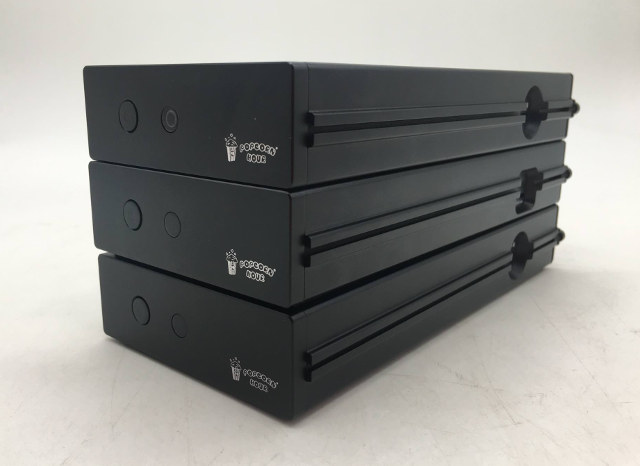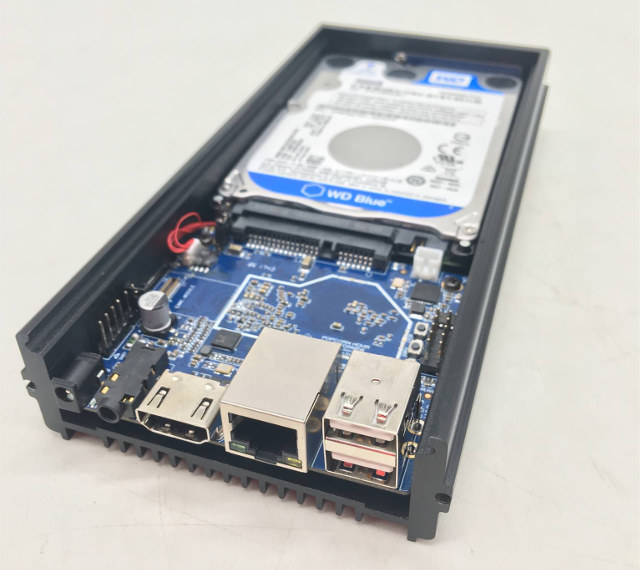Last summer, Hardkernel launched ODROID-HC1 Home Cloud 1 taking a single 2.5″ hard drive, and based on a modified version of their popular Exynos 5422 powered ODROID-XU4 board where they removed HDMI, and added a SATA interface (via USB 3.0), but based on the initial announcement, we also knew the Korean company was working on ODROID-HC2 supporting 3.5″ drives instead.
The device is not available yet, but guys at Armbian got an early unit, so we should not be waiting too long. Hardkernel will also have some competition for their ODROID-HC1 NAS, as Cloud Media (and Pine64?) are working on Rockchip RK3328 based Popcorn Hour Transformer & Transformer XL with support for 2.5″ and 3.5″ drives respectively.
Hardkernel ODROID-HC2

ODROID-HC2 preliminary specifications:
- SoC – Samsung Exynos 5422 octa-core processor with 4x ARM Cortex-A15 @ 2.0 GHz, 4x ARM Cortex-A7 @ 1.4GHz, and Mali-T628 MP6 GPU supporting OpenGL ES 3.0 / 2.0 / 1.1 and OpenCL 1.1 Full profile
- System Memory – 2GB LPDDR3 RAM PoP @ 750 MHz
- Storage
- UHS-1 micro SD slot up to 128GB
- SATA interface via JMicron JMS578 USB 3.0 to SATA bridge chipset
- The case supports 3.5″ drives
- Network Connectivity – 10/100/1000Mbps Ethernet (via USB 3.0)
- USB – 1x USB 2.0 port
- Debugging – Serial console header
- Misc – Power, status, and SATA LEDs;
- Power Supply
- 12V/2A via 5.5/2.1mm power barrel (2.5A might covered most use case, e.g. adding another USB 2.0 drive)
- Backup header for RTC battery
- Dimensions & weight – TBD
Basically everything should be the same, as HC1, except the power supply (12V vs 5V) and of course the dimensions of the metal enclosure, which is still used for cooling.
Tkaiser ran some preliminary tests, and could confirm HC2 is indeed software compatible with HC1/ODROID-XU4 using Armbian OMV image. Power consumption will be higher than for 2.5″ drives with around 5.3W measured while idle with a mechanical drive, and spikes up to 24Watts when the drive is spinning up, but apparently the 12V/2A power supply provided by hardkernel can somehow handle up to 30 Watts. Power consumption drops to 4.3W with an SSD, and 3.9W with no drive at all.
Performance was good at 100+ MB/s sequential read/write performance over the network. The reported SoC temperature will be slightly higher than on ODROID-HC1 because the 12V to 5V converter circuit produce heat that increases the PCB temperature by 3 to 4°C, but it should not be an issue.
Popcorn Hour Transformer

Popcorn Hour Transformer is quite similar to ODROID-HC1, but Cloud Media also left the HDMI 2.0 output, so it could be used as a Android TV box with hard drive too.
Preliminary specifications for Transformer based on photos, and OMV forums:
- SoC – Rockchip RK3328 quad core Cortex A53 processor with Mali-450MP GPU
- System Memory – 2GB or 4GB DRAM
- Storage
- micro SD slot
- Support for eMMC flash modules used in ROCK64 board
- SPI NOR flash
- SATA interface via USB 3.0 to SATA bridge chipset
- Support for 2.5″ drives
- Network Connectivity – Gigabit Ethernet
- Video Output – HDMI 2.0a up to 4K 60Hz with HDR support
- Audio Output – Via HDMI, and 3.5mm audio jack
- USB – 2x USB 2.0 ports
- Misc – Power button, IR receiver
- Power Supply – 5V/3A via power barrel jack
- Dimensions & weight – TBD

Transformer should be 100% compatible with ROCK64 development board, and based on latest info from #pine64 IRC channel, launch is planned for January, with Transformer XL coming a few months later. Cloud Media already listed Transformer for $95.90–$115.90, but accessing further information requires a password. Since the product has not been launched, prices may just be placeholders while designing the website.
In somewhat related news, Pine64 is working on a Rockpro64 board powered by Rockchip RK3399 SoC which will be demo’ed at FOSDEM 2018, and this may eventually lead to a Transformer Pro media NAS if there’s demand for it.

Jean-Luc started CNX Software in 2010 as a part-time endeavor, before quitting his job as a software engineering manager, and starting to write daily news, and reviews full time later in 2011.
Support CNX Software! Donate via cryptocurrencies, become a Patron on Patreon, or purchase goods on Amazon or Aliexpress





@Jean-Luc Aufranc (CNXSoft): ‘spikes up to 24Watts when the drive is spinning’ — there’s an ‘up’ missing since those consumption peaks only occur when 3.5″ HDD spin up (then there’s a huge current demand on the 12V rail to start the spindles). Afterwards even with heavy loads on both CPU and GPU cores and a disk stress test the unit stays below 24W so within the printed ratings on the PSU (that can be considered a 2.5A PSU as I’ve learned — I hope this PSU is mandatory part of the kit and it’s not able to order a HC2… Read more »
@tkaiser
The harddisks marketed for NASs (the red ones usually) deliberately keep the disk spinning (by disabling much of the power saving) to reduce access times. This has the side effect of reducing power spikes throughout the day which prolongs the life of the electronics at the expense of the mechanical parts. If using one of those, there’s a good chance the system will boot and run fine since most SoCs draw less power during the bootloader phase.
Don’t forget the Helios4 which has some unique features such as ECC memory.
24w watts is a lot for one disk, i have a small AMD C-60 board running with 3 disks and it only uses 30w.
Do those three spin up simultaneously?
RK : If using one of those, there’s a good chance the system will boot and run fine since most SoCs draw less power during the bootloader phase. There’s no problem with any 3.5″ SATA disk since I tested with the most nasty SATA HDD I’ve lying around: an older Seagate Barracuda which shows the highest peak consumption at spinup. I usually test worst case conditions since everything else is pointless. And the reported 24W in this situation are still fine since Hardkernel’s PSU is good for up to 30W. When running later intensive disk benchmarks with the Barracuda overall… Read more »
Last time I checked the xu4 armbian has no USB 3.0 with the mainline kernel.
So I guess you have to use legacy vendor kernel to use the data here?
Dx : Last time I checked the xu4 armbian has no USB 3.0 with the mainline kernel. Don’t know what you’re talking about? Anyway, of course you use either 4.9 LTS or 4.14 LTS since with the old legacy kernel storage performance sucks. Armbian/OMV currently use Hardkernel’s 4.9 LTS branch but will switch soon to 4.14 LTS, there really exists no reason to use any outdated 3.x legacy kernel here. With ODROID-XU4 and 4.x kernels some problems occur with USB3 storage due to crappy USB-to-SATA bridges (or crappy firmwares used eg. in Seagate USB3 disk enclosures) but still that’s no… Read more »
@Jean-Luc Aufranc (CNXSoft), the article states:
“Tkaiser ran from preliminary tests”
@tkaiser, is this true?
😉
@tkaiser
Sure. Though when it comes to home usage it’s worth noting running a bittorrent client means disks never really stop spinning… 😀
Btw, aren’t all these boards labeled “home usage” since they don’t have ECC?
Why can’t HardKernal provide a complete enclosure rather than half of one?!? I know it is a heat sink, but still.
Anxious to learn more about the Transformer but unfortunately their product pages are currently password protected.
@Jeroen
“spin up” refers to the specific time when the drive starts spinning, and there’s a short spike in terms of power consumption.
You can see what a typical power draw chart looks like @ http://www.45drives.com/wiki/index.php?title=Start_up_Power_Draw#Startup_Power_Draw
That’s for 15 drives, but a single drive should likely have a similar shape.
We are also developing our own NAS board based on RK3328.
http://download.kovu.io/SwiftBoard.jpg
Hardware specification:
RK3328, 1GB DRAM, Gigabit Ethernet, 8GB EMMC, HDMI 2.0, 3.5mm audio out, ASM1351 USB 3.0 to SATA bridge, 1 USB host, 1 USB OTG, 12V power barrel.
@Mike Schinkel
Looks like HK have found Aluminum ore to support passive kool these device.
@Mike Schinkel I added a full picture of HC2 enclosure: https://forum.armbian.com/topic/4983-odroid-hc1-hc2/?do=findComment&comment=45690 The plastic parts are translucent so all LEDs (the three onboard and Ethernet) shine through. In my opinion the most important part both Hardkernel and Pine folks did right is to attach the heating parts to a large metal surface. Maybe adding an additional thermal pad between PCB and the large Aluminium enclosure bottom will further help spreading some heat away from the PCB? @RK I’ve to admit I don’t understand the disk consumption discussion happening here. All I tested was a quick check whether the provided ’12V/2A’ PSU… Read more »
Hi Tkaiser, we are as sad as you. In fact we have consider and survey serveral SoC platforms. Big SoC vendors are hard to work with usually requires NDA and fees to access their platform and support. their chips are pretty pricy compared to Rockchip or Allwinner. Realtek RTD1295 is our dream platform for NAS application but their software support is quite lame and closed. We will keep looking affordable platform with reasonable software and hardware support. By the way, we enable d UASP on our platform with 4.4 kernel. We are able to achieve over 150MB/s read speed on… Read more »
@Steven I see, ‘funnily’ in the end ‘software support’ as usual wins over hardware features. Yes, with Rockchip’s 4.4 BSP kernel UAS works fine, sequential performance drops comparing UAS/USB3 with native SATA are negligible (or do not matter with a GbE NAS since network and NAS daemons are the real bottleneck) but this does not apply to random IO. Here the added USB3 layer is responsible for a massive drop in performance though this does not affect the NAS use case that much (but databases and clustering storage). And if a quality USB3-to-SATA bridge is already on the PCB users… Read more »
So is this mostly a ODROID-HC1 with a bigger heat sink on it to hold a bigger size hard drive? Or are they adding any thing else to this?
-Raymond Day
@Raymond Day
The only difference between HC1 and HC2 besides the larger enclosure is 12V for DC-IN and additional DC-DC circuitry on the board to generate 5V (and the additional voltages needed).
tkaiser : BTW: Had a conversation with Cloud Media right now and if I understood correctly then Transformer PCB allows to control powering of JMS578 and connected disks via a GPIO so with some simple scripting idle consumption of their RK3328 NAS devices can be really really low then. And I also learned (or forgot before) that on their Transformer there’s a RTC battery holder so RTC is also supported here. Hi Tkaiser, Our board also have SATA power switch(both 5v, 12v) controlled by the USB SATA bridge. you can use hdparm command to spin down the HDD which further… Read more »
@Steven
I’ve seen now at least some information is available at http://www.kovu.io — do you have a price estimate for your board and how will distribution look like?
ODROID HC2 now officially released: http://www.hardkernel.com/main/products/prdt_info.php?g_code=G151505170472
@tkaiser
Cool, HC2 switched to 12V power supply. Now it would be nice if they could use only this board on both heatsinks so that there’s no more need for a 5V input!
Obvious move since 3.5″ HDDs need 12V anyway 🙂
But of course you’re right wrt avoiding 5V input. Even a sane barrel plug like on all those ODROIDs can not prevent undervoltage hassles. Just another ‘buy cheap, buy twice’ example with HC1: https://forum.armbian.com/topic/6171-odroid-hc1-sata-disk-switches-between-sda-and-sdb/
We did not here about Rock-chip SOC, what going in this new product line.